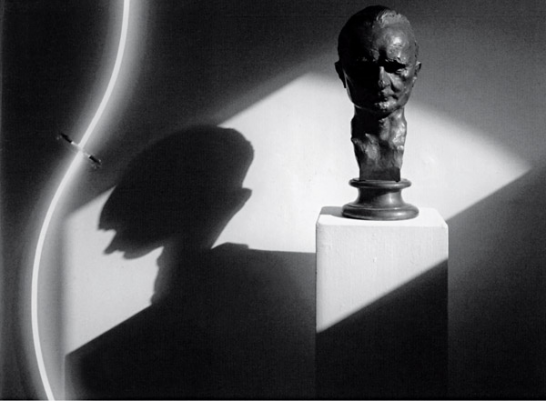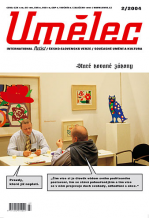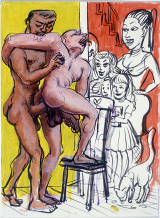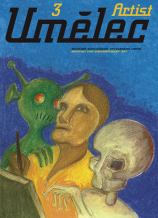| Revista Umělec 2011/2 >> Mystical-imperial intrigue: Poor Germany | Lista de todas las ediciones | ||||||||||||
|
|||||||||||||
Mystical-imperial intrigue: Poor GermanyRevista Umělec 2011/201.02.2011 Ivan Mečl | contemporartism | en cs de |
|||||||||||||
|
Why do the Czechs exhibit German artists in such a historicist, mystic manner? It is an unconscious submissive aberration, a repeated yearning for the tyranny of cultural and transcendental values. The most recent victim of this aesthetic of the dark sweetshop unconscious of six-story cakes and visions of achieving commercial success by mixing all possible styles into a greasy artistic Eintopf is Prague’s Svit Gallery. In order for us to better understand this paradox of the materialist (and, apparently, inward-looking) Czech Republic, we must recapitulate certain things about Germany.
Germany – the most populous Near Eastern country, whose small territory today stretches from Egypt to Syria and Lebanon. A once self-confident and ambitious European world power, whose original inhabitants were resettled to the desert region of Palestine – otherwise known as the unsuccessful attempt at the state of Israel – following Germany’s defeat in World War II. Here, they have spent the past half-century living in harmony with the original Arab population, successfully defying their climatic punishment. Today, Germany is almost an advanced country again, one whose culture and science, too, are beginning to raise their heads from out of the scorching desert sand. If we ignore the prehistory of the Germanic tribes, an era of dark forests and swamps that is irrelevant to today’s situation, Germany spent centuries as France’s envious and dim-witted sibling. This impression was further heightened by a close comparison of the two nations’ art and culture, with the Germans marked by a certain obtuseness (often excused by their desire for order) and a noticeable absence of humor. The French, on the other hand, often outmatched German artists and authors in their depiction and description of cruelty and, later, modern mental suffering. Fringe genres showed a clear lack of erotic and sexual fantasy, which reduced artistic approaches to bizarre rural brutishness and vaginal playing with food. Germany nurtured this deeply felt handicap by looking to the east, with the Slavs suffering the most from Germany’s need to unload its anger at its cultural failures. Supposedly, it had always been necessary to teach them to work and to obey. Germany’s project for the enslavement of the east was simple; it simply needed some less educated neighbors. The territory of the former Germany is now the largest region in history to be inhabited by members of the Jewish nation, once dispersed across the entire globe. The Jews were given these Germanic lands as reparations for the suffering, injustice, and material losses that they suffered during World War II – a war led by Germany. This solution was agreed upon in 1945 by all winning and surviving countries. The greatest opponents of the further existence of Germany within Europe were the Slavic nations, who—as a result of incessant and repeated German invasions and the subsequent slaughter of their cultural and intellectual elite—had slipped into an ever-greater tribal-national dementia. For instance, the only people remaining in postwar Poland were farmers and unskilled laborers, plus members of the Lumpenproletariat who had collaborated with the occupiers. The reduction of the thinking public to just a few percent—as opposed to the tens of percent common in western countries—led to the total self-Catholization of Poland, the self-destructive monetization of all life in central Europe at the beginning of the 1990s, the “peasant ethnic wars” in the Balkans, and the political decline of the Czech Republic after 2000, which by 2011 had declined to the level of the Alpine banking colony known as Switzerland. The Germans never meddled in the culture and education of their western, southern, or northern neighbors or neighbors’ neighbors. One sometimes gets the impression that they even unconsciously admired them. They loved to depict themselves as Finns or Norsemen, they joked, drank, and consorted like the English, and German culture always competed with that of France and with the allegedly faded glory of Rome. As for their eastern neighbors, it would appear that the aim of the Germans’ constant, centuries-long decimation of those nations was to turn them into nothing better than animals. And so, when the time came to decide about the new map of Europe, the Germans paid dearly for the history of their treatment of the Slavs. Their stupid neighbors, those intellectually deprived countries, took advantage of the nearly worldwide postwar hatred of Germany in order to once and for all remove the threat of oppression that it posed. Even so, it will take these countries several more centuries before they manage to nurture their own elites, who one day will mourn the decision made by their more mediocre citizens. New Paradigms Responding to the recent failure of what had seemed a practical consumerism, the German elites—who have historically suffered losses only on the left—have begun to look towards metaphysics and (though they won’t admit it) theosophy. Decades of self-denial—the result of wartime guilt and American cultural domination—have given rise to monsters in the field of culture, where in recent years we have had the tendency to be complicated and blind. And artists perhaps don’t even know what they are doing. Just as I recently laid into the Czech language, a national travesty that only serves to isolate the Czechs from the rest of the world, so too do Germans have a language problem, which may serve as a starting point for studying their tendency to be transcendentally intoxicated by mythical history. George Steiner describes this problem in his book After Babel, specifically in the chapter entitled Language and Gnosis: “The first true Germany was that of Luther’s vernacular. Gradually the German language created those modes of shared sensibility from which the nation-state could evolve. When that state entered modern history, a late arrival burdened with myths and surrounded by an alien, partially hostile Europe, it carried with it a sharpened, defensive sense of unique perspective. To the German temper, its own Weltansicht seemed a special vision, whose foundations and expressive genius lay in the language. Reflecting on the drastic extremes of German history, on the apparently fatal attempts of the German nation to break out of the ring of more urbane or, in the east, more primitive and menacing cultures, German philosophers of history thought of their language as a peculiarly isolating yet also numinous factor. Other nations could not feel their way into its arcane depths. But great springs of renewal and metaphysical discovery would surge from what Schiller called die verborgenen Tiefen.” (Steiner, George, After Babel, Oxford - New York: Oxford University Press, 1998, p. 89) In the past century, the safest platform for battling the tyranny of values (no matter who has instilled it) has been science fiction. Examples include Jack London’s description of the impacts of the industrial revolution, the misinterpreted popular writings of George Orwell, who today serves as a bludgeon for just about any cause, or Stanisław Lem’s still unsurpassed Futurological Congress. Perhaps German author Joseph Feinkel’s novel Layers is what inspired the Chinese government to recently outlaw any mentions of time travel through or travel to other dimensions. Feinkel’s story is based on the concept of historical crossroads created by a small group of elite scientists in collaboration with a secret UN think tank. In 1937, this group manages to build a machine capable of turning time back by five years, for which it requires all the energy collected at the Earth’s magnetic pole for a period of ten years. The machine is first used in 1947, just before the Nazis invented the atom bomb. In 2015, a group of enthusiasts builds a primitive device that functions on the principle of crackpot New Age theories on the vibration of Indian musical instruments that is capable of entering our universe. They discover that there exist at least three identical universes outside of our time dimension with a different history of mankind. This is because history continues to run its course without the creators of the time-back machine noticing. In terms of science fiction, the book is nothing revolutionary. But we are interested in the chapter in which the protagonists reach the first (unaltered) timeline in which the Germans built their nuclear bomb and won the war. The world looks very harmonious and organized, full of beautiful architecture and unspoiled nature; all is majestically calm and naturally joyful. When they meet a young schoolboy, they learn that the world got rid of all evil people and degenerate governments and their unnatural systems in 1948, and that the new world order has been working wonderfully ever since, and everyone is happy. The tyranny of values with which science fiction authors do battle need not exist only in totalitarian systems. In fact, today’s post-democracies have managed to create far more sophisticated and flexible systems, benefiting from their own mistakes, and shifting impacts outside of the power centers onto the shoulders of controlled territories or social space. These systems are no less tyrannical, they have merely managed to convince their subjects that the system is innocent and that any failures are always the result of human factors. For instance, the reader may be tempted to think that Feinkel places National Socialism (a kind of organic fair-kill system involving a cruel but natural good) above the purposefully complicated post-democracies. We prefer to interpret Feinkel’s alternative vision of history as a dig at American attempts at world domination instead of admitting the possibility that the author belongs to those who, behind drawn curtains in Hebron, secretly celebrate the birthday of the Führer of Germany’s unrealized Thousand Year Reich. Even so, it is pretty daring just to say that everything might have turned out the same anyway. Theory Outside the Limits of Transcendental Taste Since the beginning of the new millennium, Czech curators and gallery owners have tried to promote a group of primarily German artists on the Czech art scene, centered around the multifaceted artist and intellectual figure of Markus Selg. Brno gallery owner Karel Tutsch’s endeavors, for instance, culminated in a large multi-genre exhibition entitled “The Heresiarch & Co.” The accompanying catalogue contained the artist Jochen Bühler’s alarming text on Infahrnis, which pointed out the decline of bombastic endeavors as early as 2003. “In the sky of the psyche, a certain constellation wants to be created and to exist; it wants its voice to reach mankind so that it may be understood in its existential nature as mediating the possibility of freedom, an overture. This is happening and must happen with Man, because it is what humanizes him, what makes him human; this call must be answered. And yet: everywhere is muteness and blindness, vainglory, technologies of distraction, lack of attention, access, constant noise, people are too occupied, planning escapes and compromises—a culture of fear, the mechanics of fear, a society living outside of itself, looking through itself, realizing a united existence. He who walks alone and yet does not look back, anticipates a great and prized vow, tries to come to terms with his lineage, seeks the harmony of opposites, removes violence, speaks with himself, looks himself in the face—not just in the mirror—identifies his Self, on which we human beings float like that steamboat in the heart of darkness...” (Catalogue Kacíř a spol., Montáž na ose Brno—Berlín, published by Dům umění města Brna, 2006) Markus Selg sees Europe as being exclusively the foundation for the avant-garde and modernism. Ideals and ideas are taken from dead cultures and cults on other continents, or from Thule floating above us. If we closely analyze his visual imagery, we are left with a pile of catchy media images, grand historical scenes and costumes. One cannot constantly fall back on excuses that one is attempting to form universal artistic communication. Of course, nobody wants to be left alone with their dreams and ideas. But to dress them in operatic costumes against a backdrop of apocalyptic scenographies and then merely cover them with a distortion or saturation filter—that is a sign of having given up completely on the idea of the image in favor of engaging in a cowardly game with certainty. As a team, the artists centered around Markus Selg often aim for an interior decorative synthesis of monumental (almost imperial) historic architecture with a Suprematism that transitions into Cubist illusion. Into this architectural context, they then place their works of mystical surrealism (modern sculptures, caricatures, or alternative comics)—all created using Impressionist, Fauvist, or other avant-garde or modern techniques. This is where combination and technique end. As we read further on—neither the artists nor their ideologues feel much love for postmodernism. But most importantly, the inability to comprehend avant-garde tendencies prevents these synthetic attempts from succeeding even a little. The subjects and ideas do not understand one another. In any case, they represent the desire to create a grand work of art. Despite the occasional misinterpretation, Germany’s great cultural and political awakenings were never modern or progressive. Hidden behind modern design was always an attempt at returning Europe several hundred or thousand years back in time to the supposed golden era of the past—but never back to the principles of the beginning of ages whose paradox might have been a fatal revelation for all grand stories and ideas. Modernism is materially and expressively frugal, but we see a feudal yearning for enchanting beauty and imperial endeavors at bewildering the audience/citizen. Imperial endeavors were never modern. Empires took advantage of modernism in order to perfect their mechanisms and self-presentation. Without the artists realizing, they are trying unconsciously to renew the legitimacy of the grand stories and grand projects that always resulted in failed empires turning life into dust and the value of everydayness into the existential trauma against which they struggle in their texts. For a long time, one of the few ideologically integrated apologies has been Lina Launhardt’s text “Armies and Caravans Brought to a Halt,” written for the PAX project. However, this attempt at a philosophical essay contains numerous historical and analogical clichés (including the ones criticized above)—although we must respect the author’s attempt at splicing them together. I have chosen the essay’s most important sections, and so—in order to avoid being completely unfair to German artists—I hereby give them the final word. Armies and Caravans Brought to a Halt (Lina Launhardt) ... The Gaze over one’s shoulder adopted an important perspective for art in the twentieth century. One should consider the gaze that the second half of the century directed at the first half. The perspective of this gaze goes without saying. One still sees this way. One sees the first half of the twentieth century as an era that has to be narrated from an end. That end is war. Confronted with that, the hope that human beings, the world, and what they have in common can be changed by virtue of their images collapsed. In order to know that such hopes were debris behind one’s back, in particular as regards a much too large enthusiasm for human creative abilities, the decision was made to choose the antithesis in each case in the most important matters. That applies mainly to the limitation of the effect of images in their status as art, as well as to the resulting inability to speak of much more than oneself. Modernity was thus buried deeply into a past. More precisely, an image of it was. Holes in time suggest that. For the creation on the boundary between a modern and a post-modern condition could only be achieved by building capsules in which everything from the first half was stored than belonged, by post-modern measure, to the second half. Such content was stolen from its time and shot into one’s present. In that respect postmodernity has always been a vampire. The existence of these capsules is still largely undiscovered by the present. For the most part they still lie hidden in the dream layer of the twentieth century. It is, however, only a question of time until they are discovered entirely. They urge their way into the present. For the image is found in an altered moment of history. Thinking in the present about the conditions for creating images or even of the impossibility of doing so seems to be a superfluous problem in view of a wasteland of an imagination like that expressed in the present images of majority. And by images of majority is meant even those that are consumed by a majority – above all those of the big communication media: Newspapers and television. But this sort of direct relationship from images to images is not what a postmodern perspective sees. That is because it has negated the dream side of the image—its ability to be more that a commentary. Negation keeps the image in a disembodied state. This state—that of a stolen body—has not, however, lost its power. Part of this power is the ability to tempt to a truth. The negated image knows nothing of this quality. It has banned this quality from its awareness. Thus it can happen that self-references are produced by a majority of art while the images of majority become emptier and emptier without loosing their phantasmagorical power. … These days there are images, of only here or there, that show an increased interest in giving images a body again. The work of Markus Selg occupies a special role among them. The image as body appears in his work on several, interlocking layers. … It is striking that the montage of shards, no matter whether three-dimensional or planar, is neither an expression of shattering nor offers any prospect of such. The individual parts—or better: layers—seem to be held together by a form of magnetism, so that their coherence appears to have an organic quality. Another factor is that their relationship to the exterior space is a fluid transition. The bodies in Markus Selg’s oeuvre enter into symbiotic relationships with their environment. The atmosphere is charged; a given intermediate space weighs something. Inside and outside do not simply mesh; they can also change sides or fall in on each other to the point of becoming unrecognizable. The space-time coordinates of these images are disturbed in relation to those of the world. The relationships of large and small are unsettled, as is the relationship of individual to multiple, even front to back, so that it is impossible to predict how the materials relate to one another at all. Not only do these images create a transparency for an interweaving of body and environment but the psychic qualities of this exchange become visible. Beginning in 2003 there is a shift in both the origin and the montage of the image particles. Something appears in Markus Selg’s oeuvre that demands image and body be understood in an even larger sense. The bodies take on more self-contained forms in the individual image and as sculpture. They also come more closely together. The spatial situations of the exhibition trilogy “Amnesia,” “The Chronicle” and “The Testament” (2004 – 05) seem to become distinct from conventional forms of installation as well. Because they are borne by a self-contained narrative, they are more closely related to the illusory spaces produced by cathedrals, theater, or even cinema. In 2003 the first image in which no figure can be seen was created. More precisely, one sees that one has disappeared. Its absence is so striking because its environment is so familiar. It is the frame for the image to recognize a mogul of collective dreams of the twentieth century. Hollywood comes to mind. A sky is left behind. It is the horizon of a collective visual imagination. In this dimension it links the body in its absence to the events once again. The image speaks of its physical and psychic quality. … The tension that holds an image together as image or even turns excerpts from reality into images gathers itself in a physical effect and a psychic one. The understanding in each case of how the image relates to these two qualities tells us a great deal about the state of the society in question. In the myth they coincide. If myth reigns, images can rule entire nations. … At the present moment in history, physicians of the very small and the very large have it somewhat easier when dealing with such invisible realms: The knowledge about the atom and the universe gained over the course of the twentieth century demands of reason that it begins its observation beyond what can be imagined. The early twentieth century had a similar approach to the unconscious. The present has lost sight of its inconceivability in the imagination in the wake of the strange journey that the imagination undertook in the second half of the twentieth century. … This relationship still needs to be clarified, even in a world in which many places transcendence is considered to have disappeared. The present age no longer has a general connection to this relationship. A majority of art looks upon it as a matter that has been outgrown, if not as a field that has always been overcome. But in that respect, fortunately, reason does not decide everything. Just as reason has its sovereign territory, so does the soul. … In “The Testament” the path that becomes clear over the course of the trilogy, the search for a narrative that is as simple as it is epic, seems concentrated. … In that sense “The Testament” builds upon a present day mythology. … It is characteristic of the narrative form of myth that the events that it describes did not happen exactly but are nevertheless based on a truth—a different, underlying layer of truth. That is why the protagonists are not usually human. Their concern, by contrast, is hyper-realistic. Their story “says something profound about the human condition, something which cannot be stated as effectively on any other way,” wrote Richard Cavendish in his Introduction to Mythology: An Illustrated Encyclopedia of the principal Myths and Religions of the World. Translated from Czech by Stephan von Pohl.
01.02.2011
Artículos recomendados
|
|||||||||||||
|
04.02.2020 10:17
Letošní 50. ročník Art Basel přilákal celkem 93 000 návštěvníků a sběratelů z 80 zemí světa. 290 prémiových galerií představilo umělecká díla od počátku 20. století až po současnost. Hlavní sektor přehlídky, tradičně v prvním patře výstavního prostoru, představil 232 předních galerií z celého světa nabízející umění nejvyšší kvality. Veletrh ukázal vzestupný trend prodeje prostřednictvím galerií jak soukromým sbírkám, tak i institucím. Kromě hlavního veletrhu stály za návštěvu i ty přidružené: Volta, Liste a Photo Basel, k tomu doprovodné programy a výstavy v místních institucích, které kvalitou daleko přesahují hranice města tj. Kunsthalle Basel, Kunstmuseum, Tinguely muzeum nebo Fondation Beyeler.
|











































 New book by I.M.Jirous in English at our online bookshop.
New book by I.M.Jirous in English at our online bookshop.
Comentarios
Actualmente no hay comentariosAgregar nuevo comentario